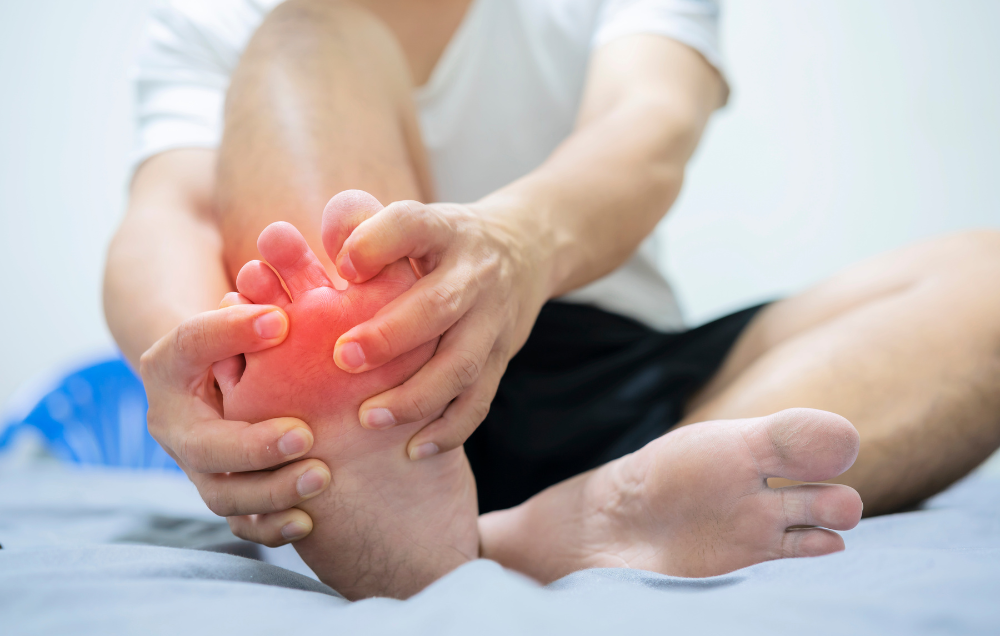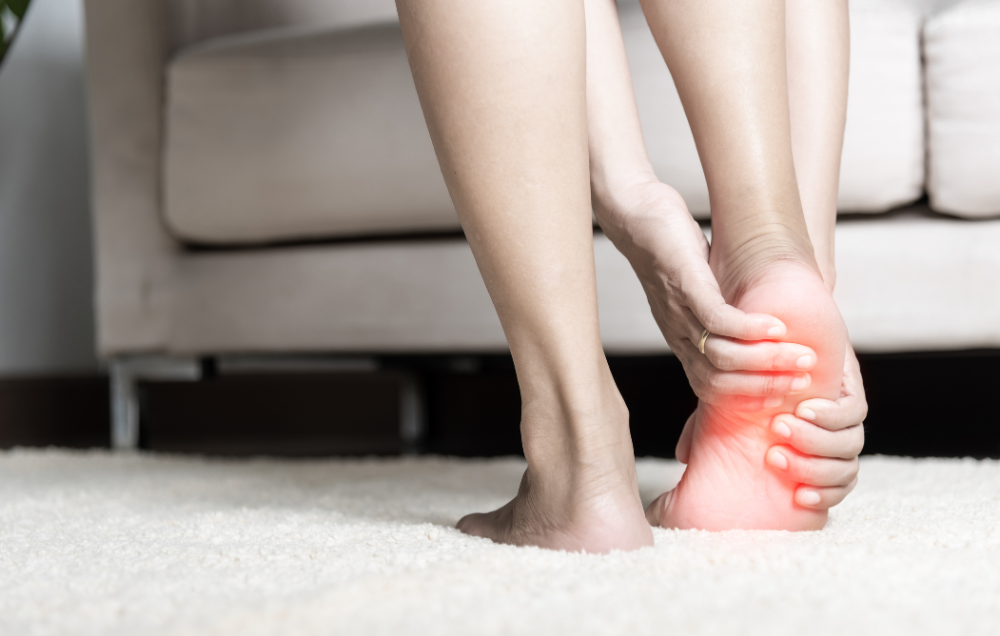Contents
Are you experiencing sharp foot pain? Foot pain can be frustrating, especially when it hinders your ability to use your foot. Foot pain can keep you off your feet, making it hard to complete your regular routine. Fortunately, foot arch pain is often treatable. A licensed physical therapist can work with you to address your sharp arch pain at the source.
When you start physical therapy, your physical therapist will provide a comprehensive evaluation. This assessment can help determine the source of your pain. One-size-fits-all solutions aren’t typically effective for treating foot pain. Once your condition is identified, your physical therapist can provide treatment tailored to your needs. Learning more about the various treatments utilized by physical therapists can illustrate how PT might help you.
Top PT treatments for sharp pain in the arch of the foot
- Manual therapy — Manual therapy involves hands-on physical therapy techniques. With these techniques, your physical therapist can use their hands to manipulate and mobilize tissue around the arch of your foot. Manual therapy techniques are tailored to each patient’s specific needs. After evaluating your condition, your physical therapist can provide specialized manual therapy treatments based on your symptoms, needs and condition. If your sharp foot arch pain is caused by a soft tissue injury, for example, your physical therapist may manipulate the injured tissue to stimulate blood flow. This can help your injured tissue receive nutrients that are vital to healing. With manual therapy techniques like soft tissue manipulation and trigger point therapy, your physical therapist can help improve your foot flexibility and reduce your pain.
- Targeted exercises — Exercises can be a great way to alleviate foot pain. Your physical therapist can recommend exercises and help you practice proper form for each one. When it comes to managing foot arch pain, it’s important to build strength and flexibility. Arch pain often occurs when the arch is not adequately supported. By strengthening the muscles in your foot, you can improve your natural arch support. To do this, your physical therapist may recommend resistance band exercises and other strengthening techniques. Flexibility can also be crucial, since arch pain can be caused by muscle tension. Stretching your foot can release tension, increasing your flexibility and reducing the stress on your arch. Your physical therapist may also recommend exercises that engage your ankles and calves.
- Ultrasound therapy — Ultrasound therapy is a specialized physical therapy modality. This treatment uses deep sound vibrations to generate heat. When applied to injured muscles, ligaments and tendons, this heat can help reduce swelling and alleviate pain. Another key benefit of ultrasound therapy is its precision. When providing treatment, your physical therapist will use a handheld ultrasound wand. The tip of this wand is applied to your surface tissue, allowing your skin to directly absorb its heat waves. This treatment method can be especially effective for managing injuries like muscle strains and ligament sprains.
What causes sharp pain in the arch of the foot?
Learning about some of the potential causes of your pain may offer insight into your own condition. Some potential causes of sharp pain in your foot arches include:
- Plantar fasciitis — According to one study, plantar fasciitis occurs in about 10% of the general population. This makes it a leading cause of foot pain, especially around the arch and heel. Plantar fasciitis develops when the plantar fascia, a thick band of tissue running across the length of your foot, becomes inflamed. Plantar fasciitis can cause sharp pain in various areas of your foot, including the arch. Your symptoms may worsen during extended periods of standing or walking. If you have plantar fasciitis, physical therapy can help you recover.
- Flat feet — Flat feet, also called fallen arches, is a condition where the arches of your feet flatten with pressure. Some people are born with flat feet. This condition can also develop later in life for various reasons, ranging from obesity to broken bones. If you have flat feet, you may feel the entirety of your foot touch the ground when you stand up. Arches serve to provide valuable support to the rest of the foot. When your arches are collapsed, your feet may take on more stress. This can lead to sharp pain around the middle of your foot. Your feet may also feel weak or swollen. If you have flat feet, your physical therapist can help you manage your symptoms.
- Stress fractures — A stress fracture is a small crack in a bone. While stress fractures are not necessarily major injuries, they can cause sharp pain and discomfort. Other symptoms may include swelling, tenderness and bruising around the injured bones. Stress fractures are typically caused by repetitive stress and harsh impacts. If you overwork your feet, your foot bones may start to develop stress fractures. The best treatments for stress fractures include rest and physical therapy.
How to address sharp pain in the arch of your foot when resting: 3 effective stretches
With targeted stretches, you can start your journey toward lasting relief. Your physical therapist can help you find stretches that work to address your particular condition. Some stretches that tend to be great for alleviating arch pain include:
- Calf stretch — Stretching your calf can help loosen tension throughout your leg. When addressing sharp foot pain, stretching your calf can be a great way to alleviate pressure around your foot arch. To stretch your calf, start in a standing position. Try to maintain proper posture, with your back and neck properly aligned. Face a wall and place your hands against it at around shoulder height. This will help you maintain balance. From here, step your left foot back behind you. Step as far as you can while still keeping your heel flat against the floor. You should feel a stretch in your left calf. Try to hold this stretch for around 20 seconds; then return to the starting position and alternate legs. Repeating this stretch can help reduce tension in your plantar fascia and Achilles tendon, allowing you to directly address potential sources of your sharp foot pain.
- Plantar fascia stretch — If you think you might have plantar fasciitis or another condition directly affecting your plantar fascia, a plantar fascia stretch may help you find relief. To stretch your plantar fascia, sit on a firm surface and cross your right foot over your left knee. Grip your toes with your right hand, pulling them back toward the right. You should feel a stretch along the bottom of your foot, particularly along your arch. Continue to gently pull for around 30 seconds; then release and alternate sides.
- Resistance stretch — Do you want to reduce tension while improving your foot strength? Incorporating resistance exercises into your routine can help. To do a simple resistance stretch with your foot, you’ll need a resistance band. If you don’t have a resistance band, a towel can work as well. Start by sitting on the floor with one leg extended in front of you. Loop your band around the ball of the extended foot; then use a hand on each side of the band to pull the band toward you. You may feel this stretch engaging your arch, ankle and calf. After holding for 20-30 seconds, you can release and switch to the other foot.
Lattimore Physical Therapy can help you experience lasting foot pain relief
Lattimore Physical Therapy can help you kick-start your recovery journey. When it comes to treating foot pain, we offer a range of evidence-based techniques designed to deliver great results. Our team of licensed physical therapists is committed to helping each patient experience relief and achieve their long-term wellness goals.
Contact our team today for more information or to schedule an initial appointment for your foot pain.



